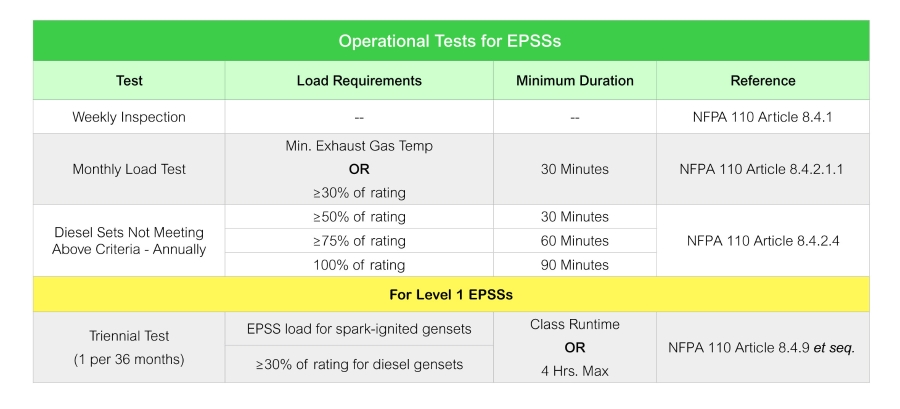Regardless of how carefully a backup power system is designed, it won’t matter if the system doesn’t provide power when its needed most. How can facilities know whether their backup power system will be ready and available? By implementing an adequate program of maintenance and testing.
An Overview of NFPA 110
The National Fire Protection Agency publishes NFPA 110 - Standard for Emergency and Standby Power Systems. It provides minimum guidance on the design, installation, maintenance, and testing of backup power systems, guidance that is referenced by other industry standards such as NFPA 70 – National Electrical Code, NFPA 99 – The Healthcare Facilities Code, and The Joint Commission Hospital Accreditation Standards. Furthermore, reliable backup power is not just an issue for healthcare … The Uptime Institute reports that 36% of data center outages are power-related.
Key Provisions
NFPA 110 categorizes Emergency Power Supply Systems (EPSS), then prescribes requirements for installation, system maintenance, and periodic operational testing as follows.
EPSS Categories
NFPA identifies backup power systems by Class, Type, and Level.
Class
The code classifies EPSS into classes according to the amount of time that they must be able to provide power without refueling or recharging. Five time classes range from 5 minutes to 48 hours, and a sixth class allows the runtime to be defined by application, code, or the user.
An Overview of NFPA 110
The National Fire Protection Agency publishes NFPA 110 - Standard for Emergency and Standby Power Systems. It provides minimum guidance on the design, installation, maintenance, and testing of backup power systems, guidance that is referenced by other industry standards such as NFPA 70 – National Electrical Code, NFPA 99 – The Healthcare Facilities Code, and The Joint Commission Hospital Accreditation Standards. Furthermore, reliable backup power is not just an issue for healthcare … The Uptime Institute reports that 36% of data center outages are power-related.
Key Provisions
NFPA 110 categorizes Emergency Power Supply Systems (EPSS), then prescribes requirements for installation, system maintenance, and periodic operational testing as follows.
EPSS Categories
NFPA identifies backup power systems by Class, Type, and Level.
Class
The code classifies EPSS into classes according to the amount of time that they must be able to provide power without refueling or recharging. Five time classes range from 5 minutes to 48 hours, and a sixth class allows the runtime to be defined by application, code, or the user.





